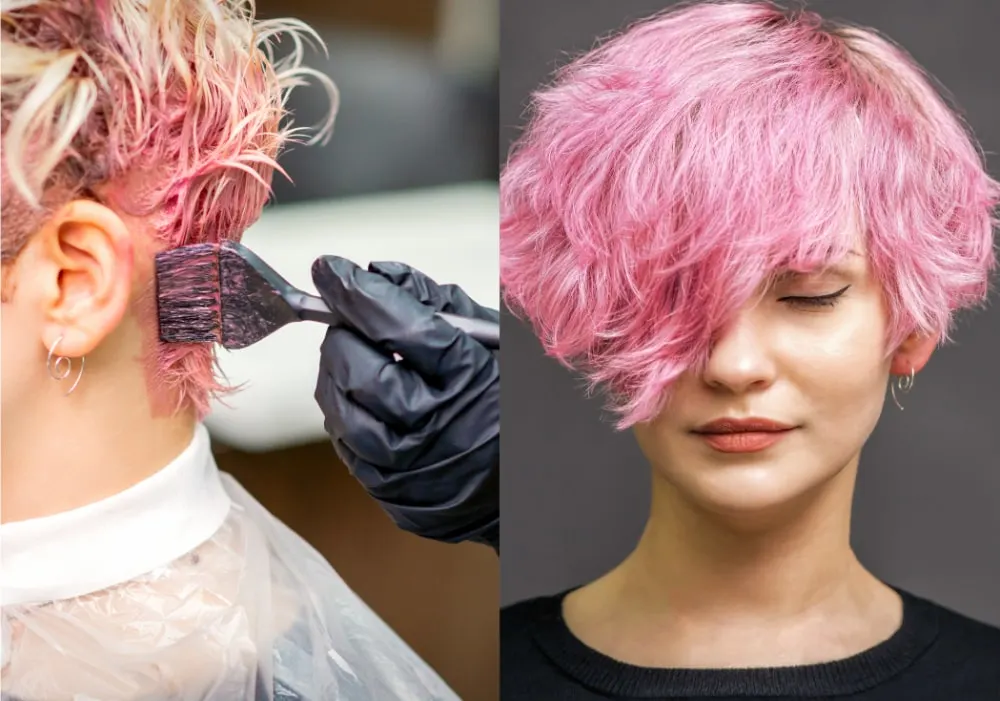Semi-permanent hair dyes are an effective way to give your hair a new shade of color. However, what if your hair is already colored with permanent dye?
Can you apply semi-permanent dye over the permanent color and still get your desired result?
We have answered this question below and also discussed the pros and cons. Read this article till the end so you can determine if dying semi-permanent hair color over permanent is the right choice or not.
Is It Possible to Put Semi-Permanent Dye Over Permanent Dye?
Yes, you can apply semi-permanent dye over permanent dye. However, the semi-permanent dye you apply should be darker than the permanent dye to ensure it shows effectively.

Some factors will affect the success of using semi-permanent dye on top of permanent dye. They are:
- Your desired hair color
- The type of dye you used
- The condition of your hair
Suppose you have dyed your hair using a permanent dye that didn’t come out correctly. In that case, you can generally fix it with semi-permanent dye. Apply a layer of semi-permanent dye over the initial permanent dye. You will even out the color to be consistent.
Using semi-permanent dye over permanent dye will only give your hair a small amount of damage from this application. Make sure not to use this method if your hair is damaged heavily.
While you can usually use semi-permanent dye to fix a permanent dye job, you can’t do it to lighten your hair. Applying a lighter semi-permanent dye over a permanent dye will not lighten the color of that dye job.
Semi-permanent hair dye doesn’t have any peroxide, meaning it is not as strong and will not overpower a dark base color.
Benefits and Drawbacks of Using Semi-Permanent Dye Over Permanent Dye
While using semi-permanent dye to patch up a permanent dye job can be effective, there are both upsides and downsides to this process.
Pros
- Using semi-permanent dye over permanent dye is that it is less damaging to your hair. While not as strong as its permanent counterpart, semi-permanent dye is certainly less harmful to your hair. You will want to use it when possible to prevent extra damage.
- Semi-permanent dye works well when covering gray hair or other inconsistent colors in your hair dye. While you can use a permanent dye to change these areas as well, semi-permanent dye is much easier to remove.
- If you like to change the color of your hair a lot, you won’t want to cover your head and permanent dye all the time.
Cons
- On the other hand, the apparent disadvantage of semi-permanent dye is its strength. Because it is easier to remove and less damaging for your hair, this dye may not last nearly as long as a permanent dye, nor will it always cover in a consistent coat.
- You may still notice grays in your hair after using semi-permanent dye.
How to Use Semi-Permanent Dye Over Permanent Dye?

To receive the best results after applying a semi-permanent hair dye, you will want to ensure you prepare your hair and use it correctly.
Make sure you cleanse your scalp of dirt and build-up before using the hair dye. It is better to wash your hair with a shampoo at least a day before you apply the dye as freshly washed hair is not recommended.
Once your hair is prepared, put some gloves on and coat your hair with the semi-permanent dye. Your hair dye will have instructions for how long to leave the dye there, but it will generally be between 20 minutes and an hour.
Semi-permanent dye is not bad for your hair, so going a little over the recommended time shouldn’t cause any long-standing damage.
Once your hair dye sits long enough, rinse out the dye. Your hair should be the color you’d like.
Expert Recommendations
Here are some tips recommended by the experts to achieve the best rest result when you are dying over permanent dye with a semi-permanent hair color:
- It’s advisable to wait until the permanent dye has faded significantly. This allows the semi-permanent dye to show up more vividly.
- If you’re applying a semi-permanent dye over a darker permanent shade, opt for a semi-permanent color that is either similar or darker. Lighter semi-permanent colors may not show up on darker permanent dyes.
- Semi-permanent dyes are generally less damaging than permanent dyes, but if your hair is already damaged from the permanent dye, be cautious. Deep conditioning treatments before applying the semi-permanent dye can help.
- A great way to test if your semi-permanent dye will work well on top of your permanent dye is to start with a small area. Dye only a few strands of uneven hair and see how it turns out before committing to your entire head.
So, while it is possible to dye a semi-permanent color on top of permanently dyed hair, you can decide whether you should do it or not based on the factors, pros and cons, and expert recommendations.
FAQs
While we have covered a lot of important information about hair dye, you may still have some questions. Here are some of the most frequently asked questions about semi-permanent and permanent hair dye:
In an ideal world, permanent hair dye would be just that, permanent. Unfortunately, permanent hair dye will need to be touched up every 6-8 weeks as your roots grow.
While not common, some types of permanent hair dye can also fade on your head sooner than this 6-8 week period.
You will want to dry your hair before applying semi-permanent dye to it. Placing semi-permanent dye on wet hair may result in issues with your hair dye.
Wet hair won’t always absorb the color of hair dye, and it may turn out uneven because of this.
